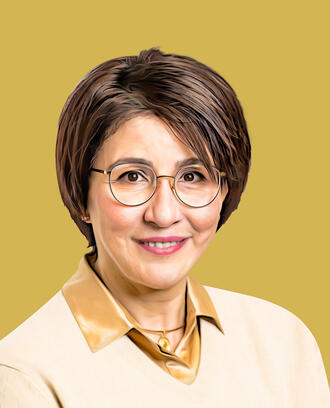Ideas Made to Matter
Health Care
How holography could get us to non-invasive surgery
By
In 1995, only a few years removed from building the world’s first holographic video system, Mary Lou Jepsen was in a wheelchair, her face drooping, her head often pounding, her bodies covered in sores.
“I dropped out of graduate school to go home to die because nobody could figure out what wrong with me,” Jepsen, SM ’89, said in a new podcast interview with MIT Sloan’s Andrew McAfee.
A medical school professor paid for Jepsen, then working primarily as a holographic artist, to get an MRI, which revealed a brain tumor. Surgery removed the tumor, and Jepsen successfully petitioned to return to her PhD program.
After that, her career shifted from art to engineering — partly to pay her health care bills, she said, but partly to be more mission-driven. Today she is CEO and founder at Openwater, a startup developing portable and wearable high-resolution imaging technology to help doctors and patients see into the body.
In her conversation with McAfee, co-director of the MIT Initiative on the Digital Economy, Jepsen explained how Openwater’s tech could make the leap from medical imaging to non-invasive surgery, how she’ll use China’s massive supply chain, and why intellectual property comes before a scientific advisory board.
Surgery worthy of science fiction
The device Openwater is developing uses infrared light to scan the body and displays images on an LCD screen — no different than the screen in today’s smartphones, powered by camera chips — with pixels as small as one micron. It’s a far cry from the millimeter-sized pixels common when Jepsen made her first holography machine, which occupied an entire room, at the MIT Media Lab.
Such a device would replace the multimillion-dollar “big iron” MRI machines, and their $500,000 in annual maintenance costs, with a device the size of a smartphone that allows doctors to go to patients, and not the other way around.
“I nearly died because an MRI was too expensive,” Jepsen said, later saying that “we can stop making this decision of ‘The rich live, the poor die,’ because that’s even more true now than it’s been in the past.”
Jensen believes the same technology could be used for non-invasive surgery by way of photodynamic therapy, targeting individual cells in the body.
“Can we actually see if there’s a problem and then operate remotely using these things? Non-invasively, no cutting open, just even cellularly?” she asked. “Can we get rid of drugs because we can deliver something to a cell?”
Taking advantage of a global supply chain
Jensen holds more than 200 patents. Many stem from her work at Intel, Google, and Facebook, where her patented high-resolution augmented reality glasses were part of CEO Mark Zuckerberg’s vision to get 1 billion AR and virtual reality users.
This work allowed her — as well as companies including Sony and Microsoft — to influence the manufacturing supply chain in Asia, where factories can churn out millions of units per month.
“Everybody wanted smaller pixel sizes for next-generation, high-fidelity virtual reality and augmented reality. So those manufacturing processes had been put in place in the low-margin factories, these multibillion dollar factories that make the world’s screens,” she said.
Jensen looked at that supply chain and saw an opportunity to use the technology in something besides glasses, goggles, or smartphones.
“I just realized ‘Wow, we could do something so much bigger than VR and AR.’ … We’re missing a lot of stuff,” she said.
IP first
One piece of advice Jepsen hears is to form a scientific advisory board for Openwater, as her background is physics and engineering.
Jepsen said she is confident that advisors and collaborators will come. When she co-founded One Laptop per Child with Nicholas Negroponte, it was just the two of them, but so many people wanted to help that “we had to figure out how to take help.”
Plus, she added, product management is a higher priority so that the company can protect its intellectual property.
“People can come kick the tires, but actually we’re just running full blast making this,” Jepsen said. “And we’ll get that, and we’ll do peer-reviewed stuff, but in fact the way this works is you have to file the patents first. Because it’s first to file now, not first to invent.”



